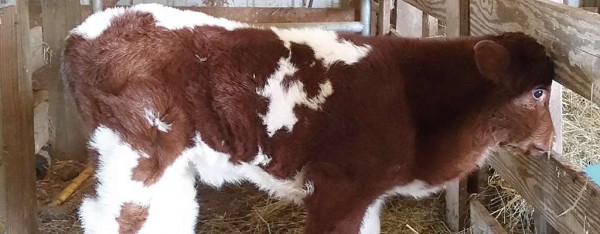
Dubbed “Cardio Brisket” by its owner, Tom Leech, this shorthorn calf was born at Longview Farm in Washington, Pennsylvania, March 7. The calf suffers from a rare condition that allows its heart to move into its neck area. Leech said he has only found two other confirmed cases of similar conditions. (Submitted photo)
When Tom Leech of Longview Farm found a newborn Shorthorn bull calf in a pasture on the afternoon of March 7, he was immediately concerned with hypothermia.
He warmed the calf with an electric blanket and it started sucking on his mother right away. Then Leech saw something that worried him more than losing the calf to the cold.
“I noticed something pumping in his brisket area and figured it was an artery, or that he was still cold, or maybe something was stuck in his throat.”
But when he checked, Leech discovered the pumping in the neck was actually the calf’s heart.
“Once you grabbed it, you could tell it was his heart; you could feel it and see it moving back and forth,” Leech said.
He texted his vet and said, ‘if you’re in the area Monday, you might want to stop by.’”
Rare phenomenon
Todd Moores, of Wheeling Veterinary Associates in Wheeling, West Virginia, said the condition the calf suffers from is similar to thoracic inlet syndrome in humans.
“The heart is outside its chest and in its sternum areas, where the esophagus and trachea come together,” Moores said. “But with thoracic inlet, there is less room.
“In this case, the heart has been able to prolapse into the brisket area — the area is probably four to six times bigger than it should be.”
Moores has done only an external examination of the calf, which Leech named “Cardio Brisket”, but he suspects the sternum failed to form fully, or the calf is missing ribs.
“You can actually take the heart and move it back, but it won’t stay,” Moores said.
The doctor contacted researchers at the Ohio State Veterinary Medical Center, who agreed to study the calf to determine arterial damage or if the heart is transposed. The university could not, however, guarantee the calf’s survival. Leech passed on the offer.
Barn calf
Leech, his wife, Debbie, and the family raises 22 head, including calves, and Leech has been a cattleman for more than 40 years. He said he has been able to confirm only a couple cases of a calf with Cardio Brisket’s condition — one in Turkey and another in Kentucky in 1903.
Friends also told Leech they had a similar thing happen with a calf 14 or 15 years ago at Byland Polled Shorthorns in Loundonville, Ohio.
“They cut him open and he only lived an hour.”
For now, Cardio Brisket’s future is much brighter.
“I won’t be able to put him out with the others because if they get to roughousing, they could probably puncture it,” Leech said. “So he is going to be a barn calf. Unfortunately, I’m growing kind of attached to him.”
Leech said the long-range plan is to treat him like any other steer being fed out to market.
“If he dies under my control though, we will cut him up and see (what caused the heart condition),” he said. “If nothing else, out of curiosity.”
Prognosis
Moores said the calf is doing well, but is understandably more averse to cold weather, is not growing at the same rate as other calves, and suffers from a heart murmur.
“You could go to the effort to fix (the condition) as a baby, but it wouldn’t be economical,” he said. “The condition seems to be congenital and embryonic — a defect in which an area should close off but doesn’t.”
The result, Moores said, is a “shunting” of the blood that should be getting to the lungs. The lack of oxygenated blood to tissue, he said, will make the calf more susceptible to disease and infection as it grows.
“Also, the heart is not in the center of its body like it should be, it is just hanging out in the skin,” he added. “So its body is probably not being kept as warm as it should be.”
Unusual
Moores said that in his career he has seen numerous birth defects, “from five-legged pigs to two-headed calves.”
“Two-headed calves are pretty dramatic, but this is probably the most dramatic thing I’ve ever seen,” he said. “And probably something we’ll never see again.”
While he is not quite as optimistic about the calf’s lifespan as Leech is, Moores said he is in agreement with the farmer’s game plan.
“I think Tom’s plan is to let the calf live as long as it can,” Moore said. “I think he’s grown kind of fond of it.”
Source: Farm and Dairy









